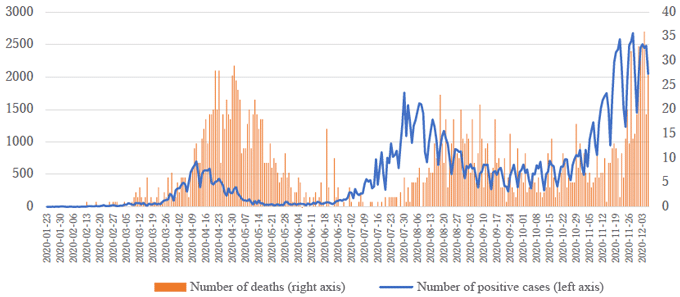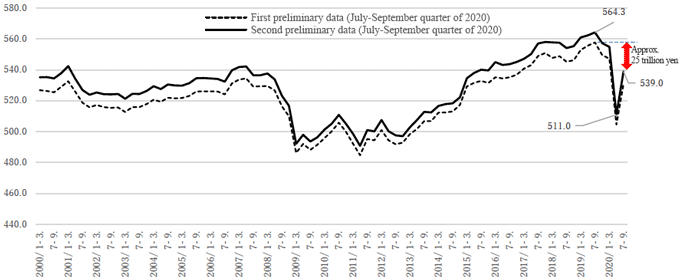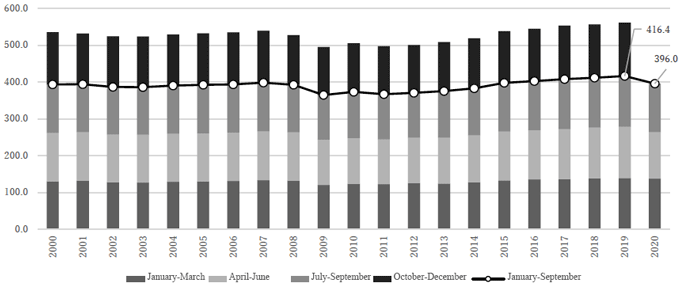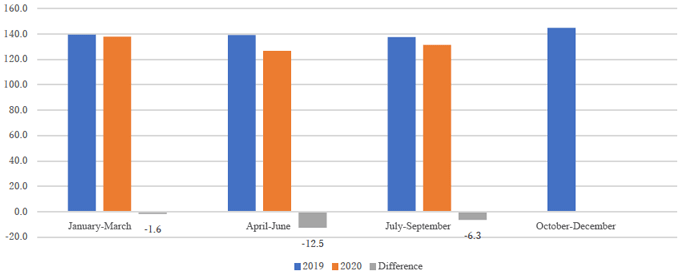The novel coronavirus (COVID-19) outbreak in Japan temporarily subsided in August 2020 and thereafter, but infections started to spread again in November. In Figure 1, the line graph (blue) represents the daily number of positive cases and the bar graph (red) represents the daily number of deaths. Judging from the shapes of the graphs, it is not too much to say that the third wave of COVID-19 is now sweeping through Japan.

[Click to enlarge]
Under these circumstances, what are the prospects for the Japanese economy in 2021? Forecasting the future direction of the economy is very difficult in these circumstances, as that depends on the efficacy and side effect risks of vaccines developed by Pfizer and Moderna and future COVID-19 infection trends, among other factors. However, it is also important to keep track of the current macroeconomic situation.
What indicators are useful regarding the current macroeconomic situation? One useful indicator is preliminary data on quarterly GDP periodically announced by the Cabinet Office. What insights can we glean from the most recent quarterly GDP data (early December) (the second preliminary estimate of GDP in the July-September quarter of 2020), which were published on December 8, 2020?
First, let us look at the seasonally adjusted GDP data series in Figure 2. According to this data series, which represents annualized estimates calculated by making seasonal adjustments to original nominal GDP data for the period from the January-March quarter of 2000 to the July-September quarter of 2020, nominal GDP peaked at 564.3 trillion yen in the July-September quarter of 2019.
In the April-June quarter of 2020, nominal GDP declined to 511.0 trillion yen because of the spread of COVID-19 infections and the voluntary stay-at-home and store closure requests following the declaration of a state of emergency in early April. However, in the July-September quarter of the same year, nominal GDP recovered to 539.0 trillion yen as a result of the full removal of the state of emergency declaration in late May, the enactment of the first and second supplementary budgets for fiscal 2020, and the subsequent moderate recovery in economic activity.
Even so, the economic recovery still has some way to go, with nominal GDP in the July-September quarter of 2020 as much as approximately 25 trillion yen below the peak level (the July-September quarter of 2019).

[Click to enlarge]
Therefore, some people within the government have started to point out the need for an additional economic package worth 30 to 40 trillion yen. As the numbers in Figure 2 are annualized estimates obtained through seasonal adjustment of quarterly data, we must also examine the original GDP data series.
What do the original data in Figure 3 tell us? At present (late November 2020), there is no way of knowing what the nominal GDP in the October-December quarter of 2020 will be, so Figure 2 shows the nominal GDP for January-September of each year from 2000 to 2020, represented by the line graph and calculated on the basis of quarterly GDP data for the same period. The nominal GDP for January-September of 2020 (396.0 trillion yen) is approximately 20 trillion yen lower than the peak of the line graph, which is the number for January-September of 2019 (416.4 trillion yen).

[Click to enlarge]
Therefore, if the nominal GDP for the October-December quarter of 2020 recovers to a level similar to the number for the October-December quarter of 2019, nominal GDP for 2020 will be down approximately 20 trillion yen, rather than approximately 25 trillion yen, from the level in 2019.
In this respect, what's important is the pace of recovery in economic activity. This becomes clear when we compare figures in 2019 and 2020 based on the original data series as shown in Figure 4. Because of the impact of the declaration of a state of emergency, the GDP in the April-June quarter of 2020, which was the most difficult period, was as much as 12.5 trillion yen short of the level for the April-June quarter of 2019. However, in the July-September quarter of 2020, when economic activity started to recover at a moderate pace, the year-on-year shortfall compared with the July-September quarter of 2019 narrowed to 6.3 trillion yen.
If this trend continues, nominal GDP in the October-December quarter of 2020 may improve more than in the July-September quarter, but that depends on future infection trends. At the recent extraordinary cabinet meeting (December 8, 2020), the government formally adopted an additional economic package (worth 40 trillion yen in fiscal expenditure, including general-account budget funds and fiscal loans and investments). However, now that there are once again signs of COVID-19 infections spreading due to weather changes following the arrival of winter, the Japanese economy is at a critical juncture.
If infections spread further, leading to reintroduction of the voluntary restrictions imposed in April-May 2020, there is the risk that the damage to social and economic activities may further deteriorate. However, if Japan manages to get through the pandemic this winter, the situation may change dramatically. While vaccines for COVID-19 are under development, it has become clear during the past year that the principles for infection prevention are testing, tracing and quarantine. To contain the pandemic and keep the economy going at the same time, now is the time to fundamentally enhance the testing regime so that we can verify who among us are infected and who are not, and then engage in normal activity with a much-reduced level of risk or concern.

[Click to enlarge]


